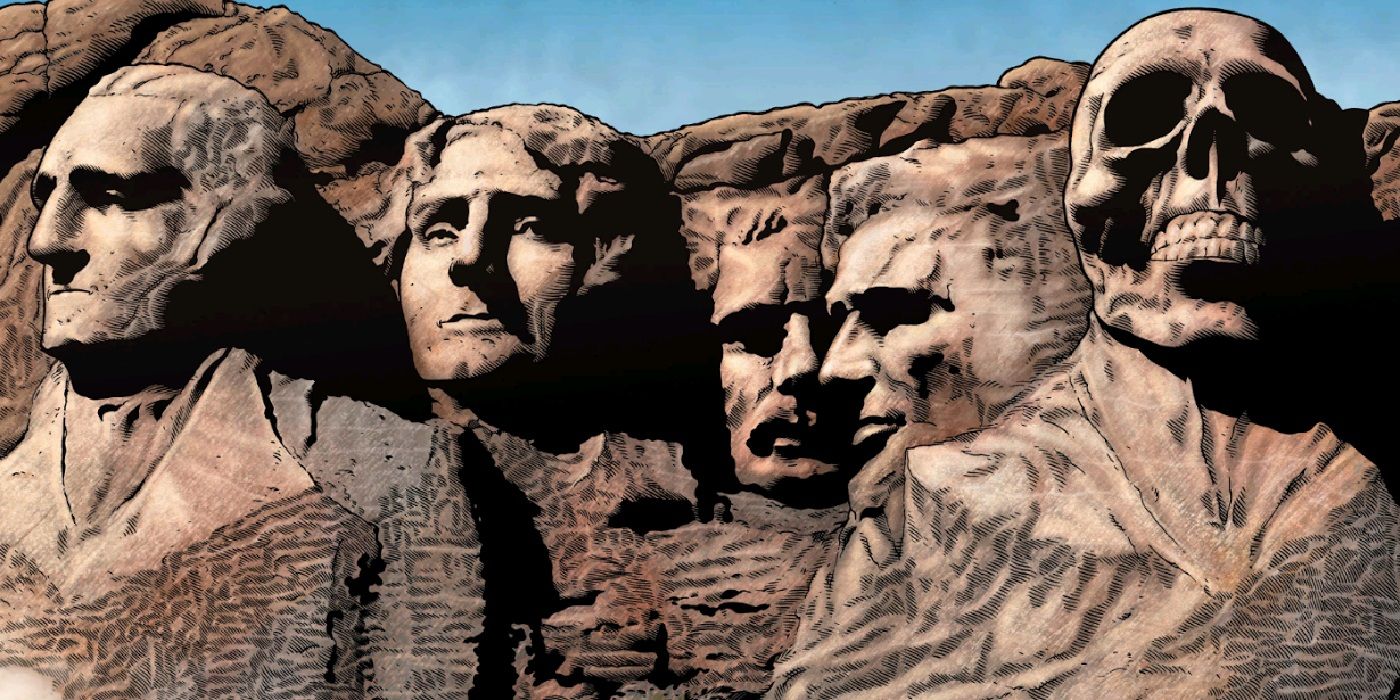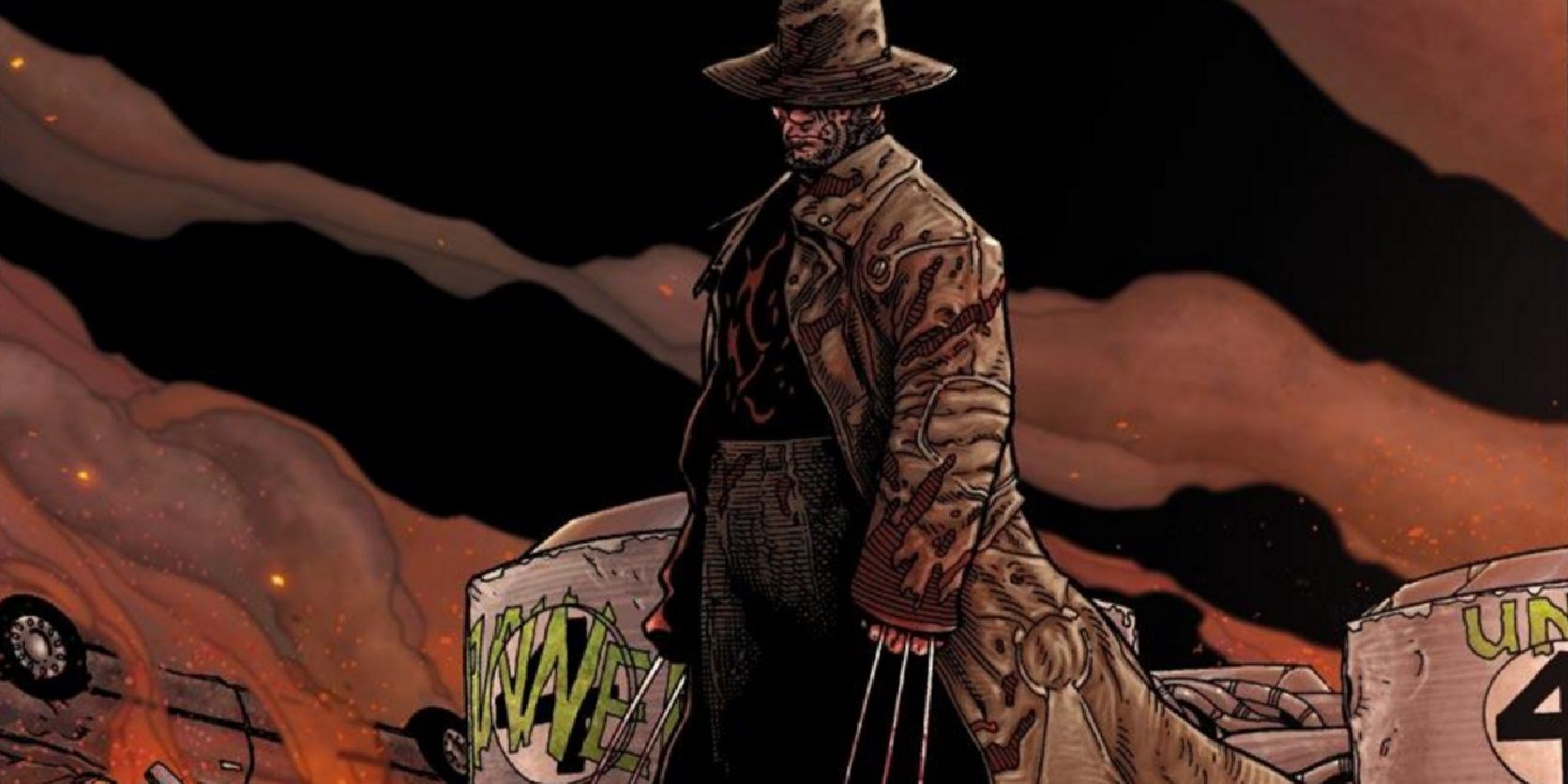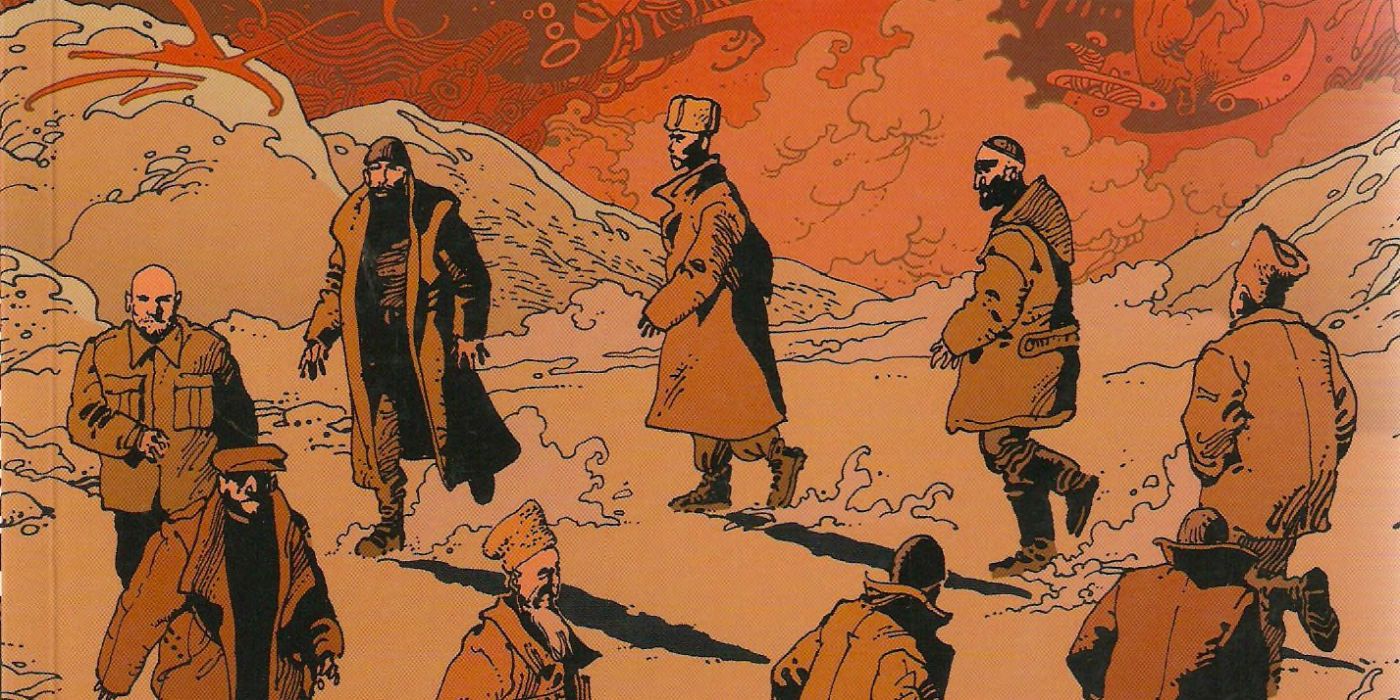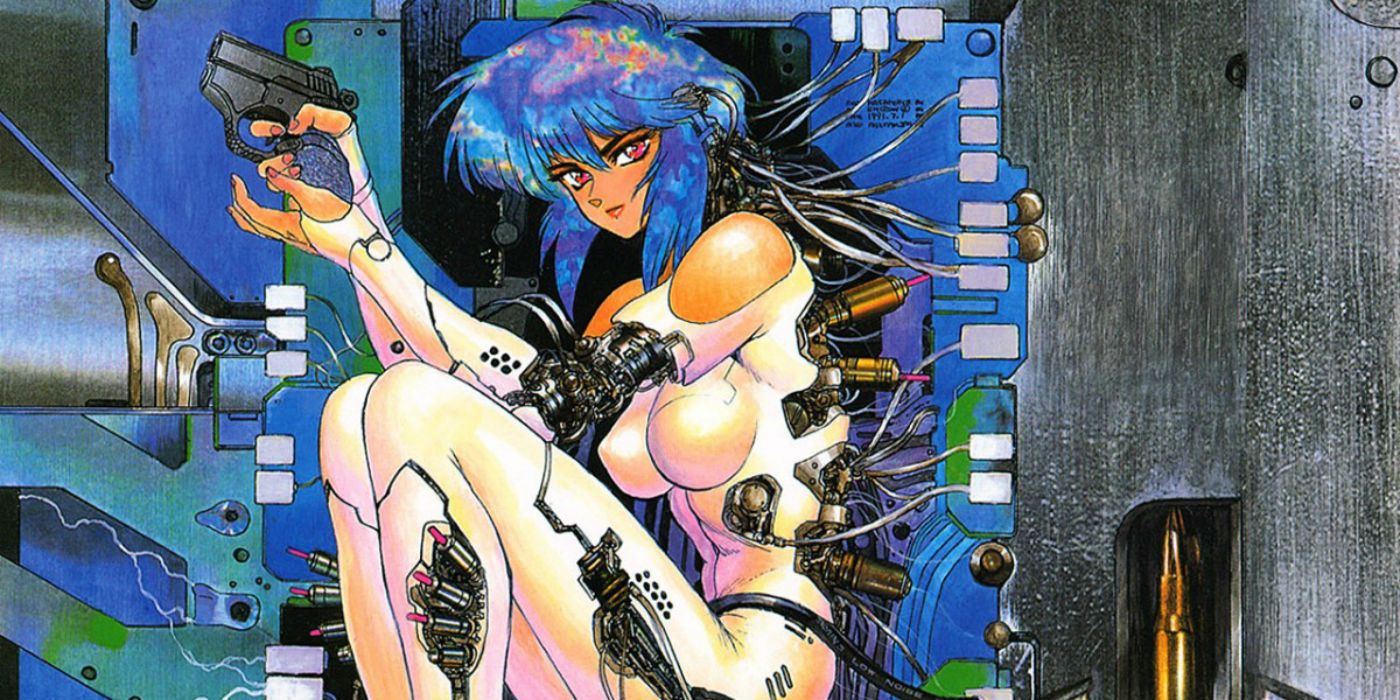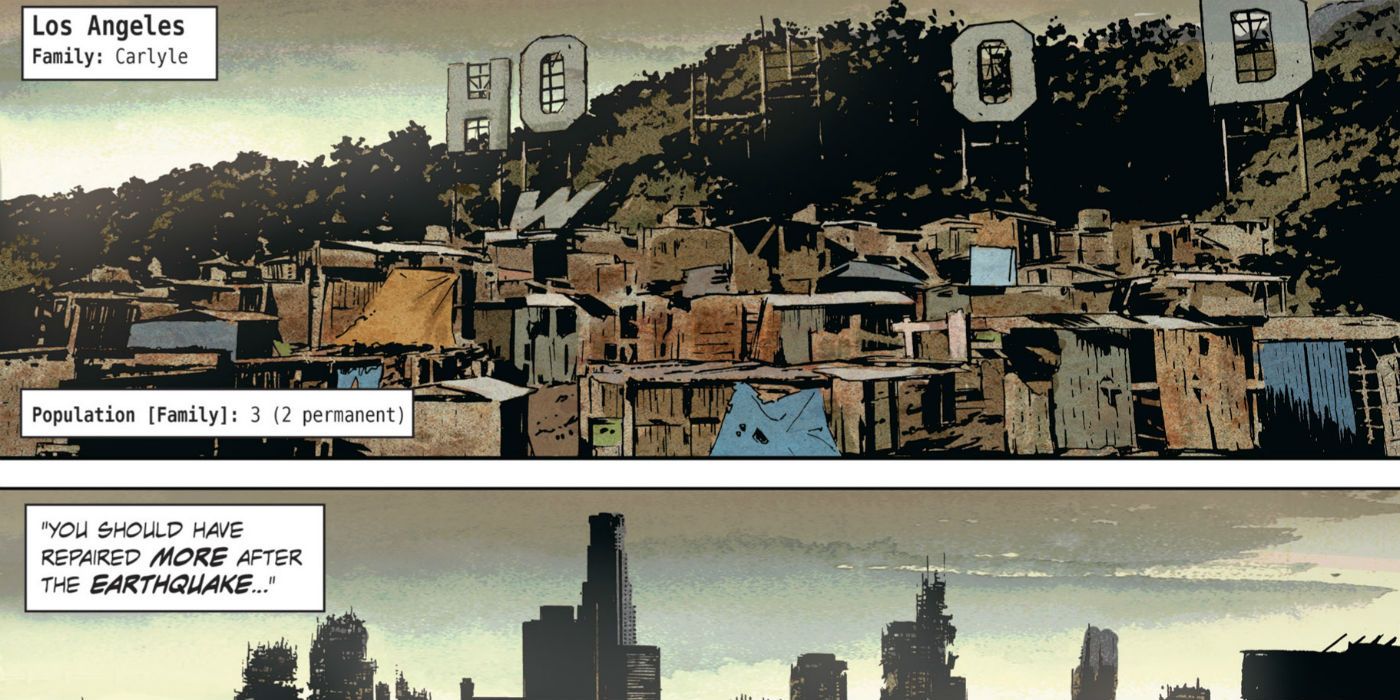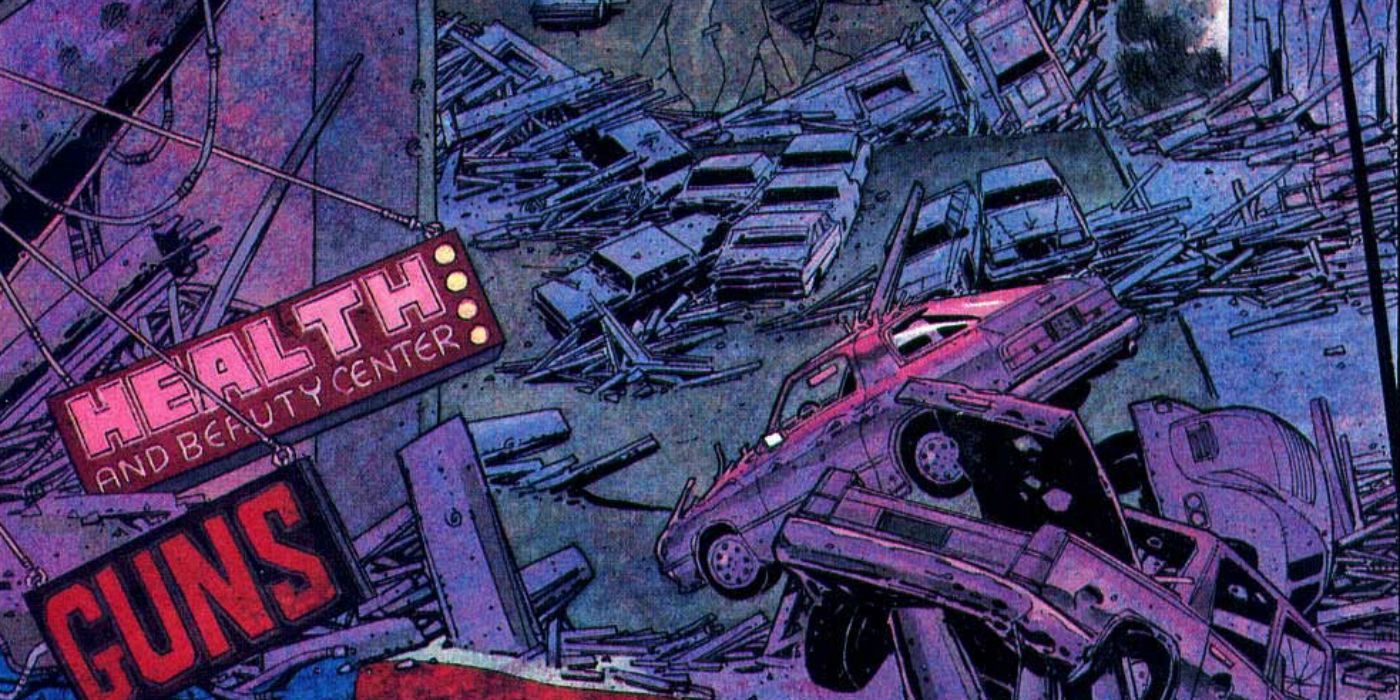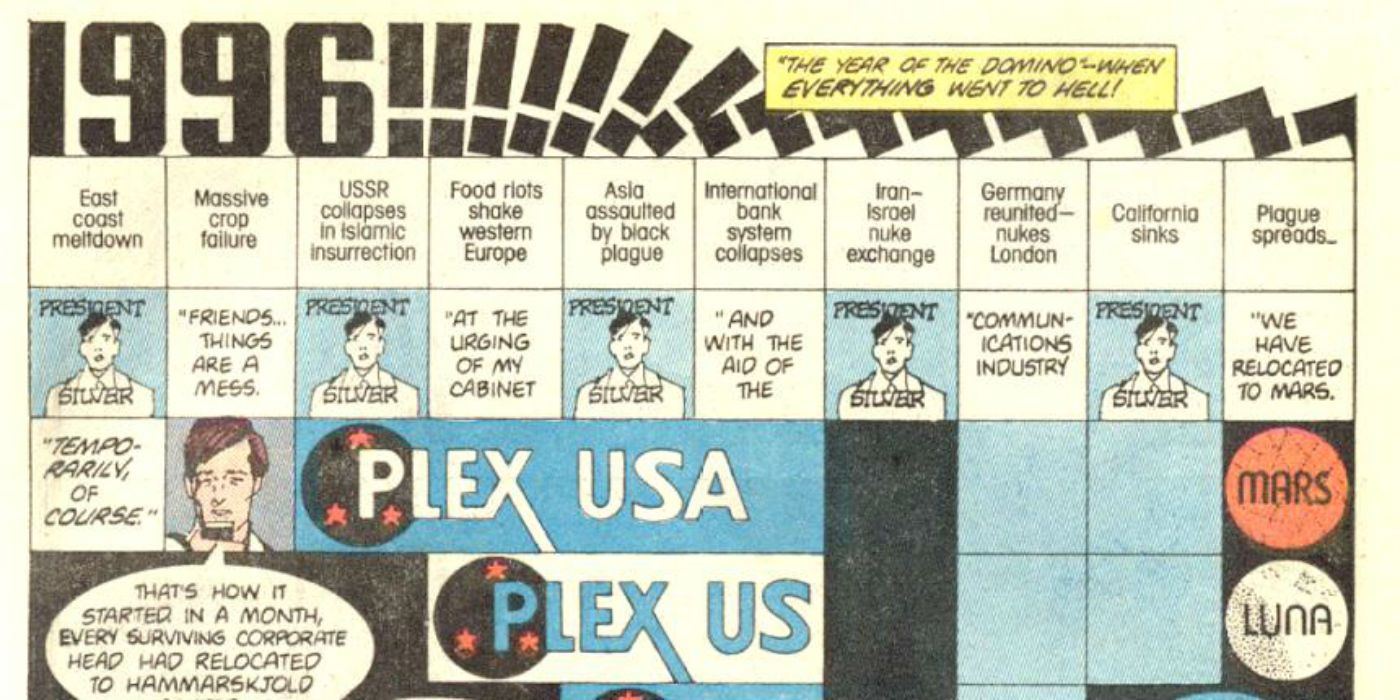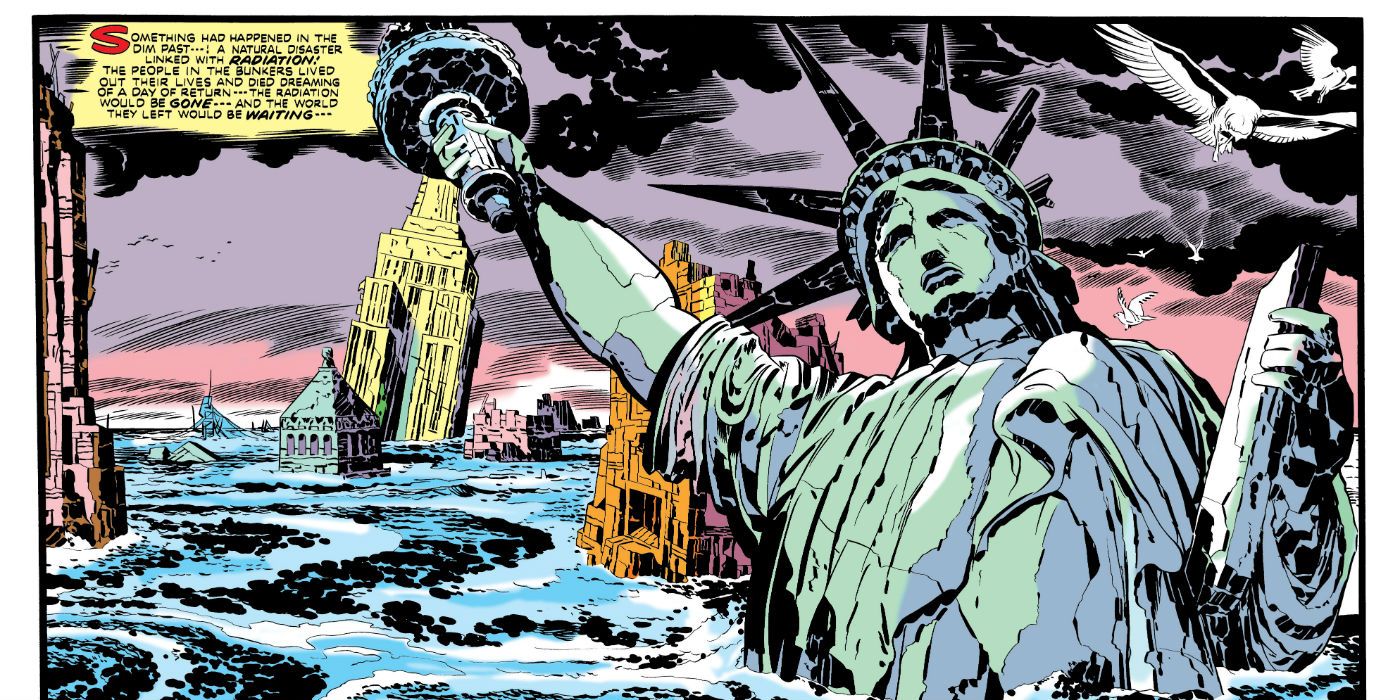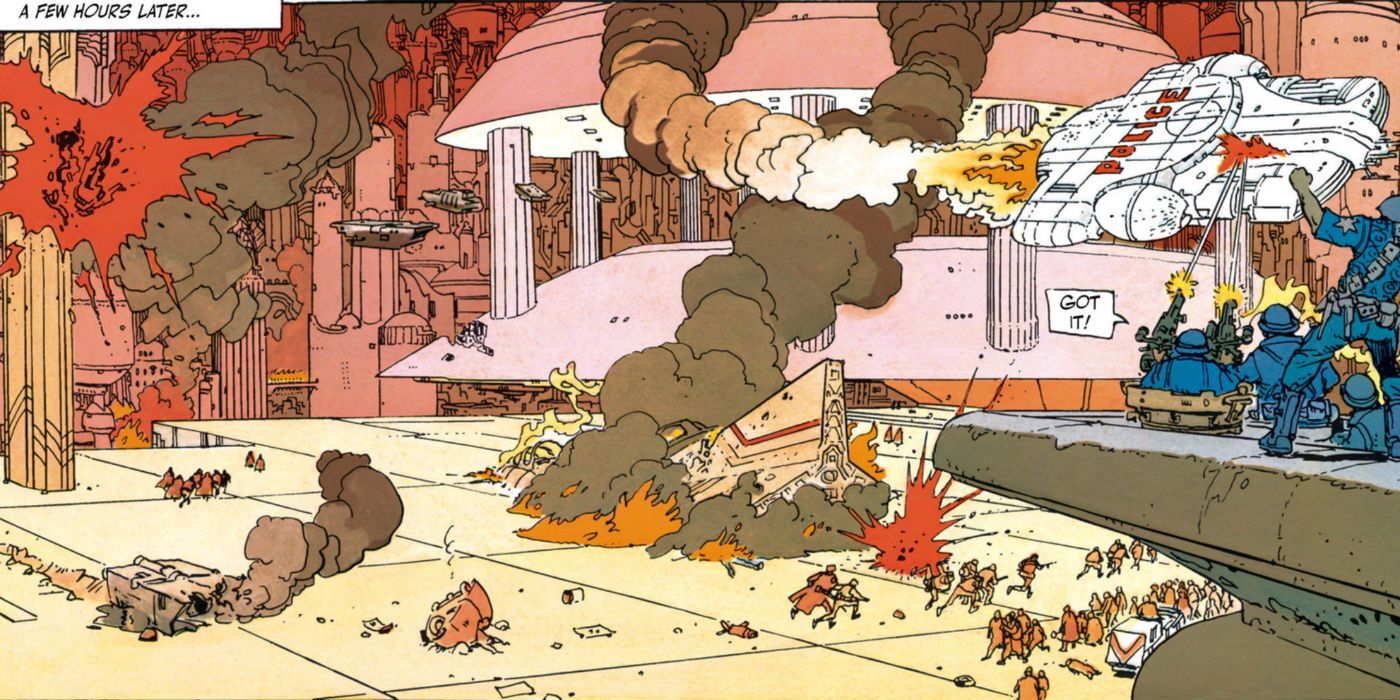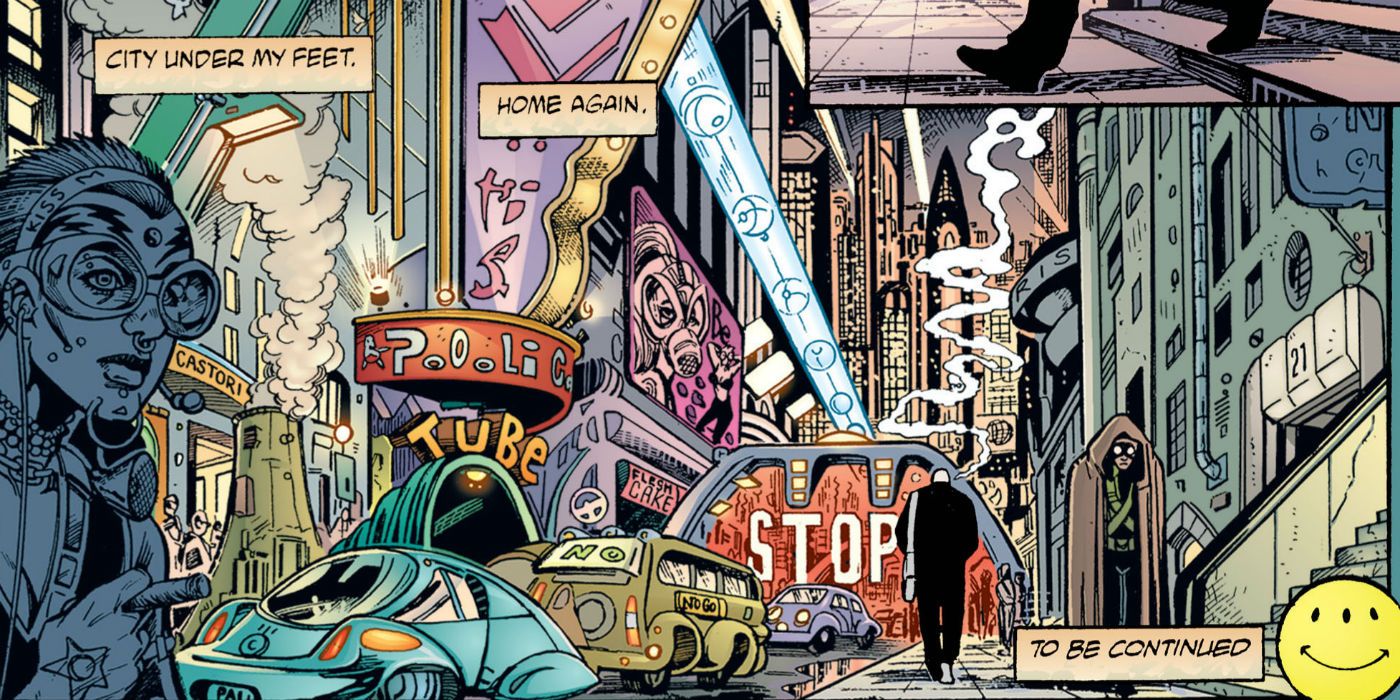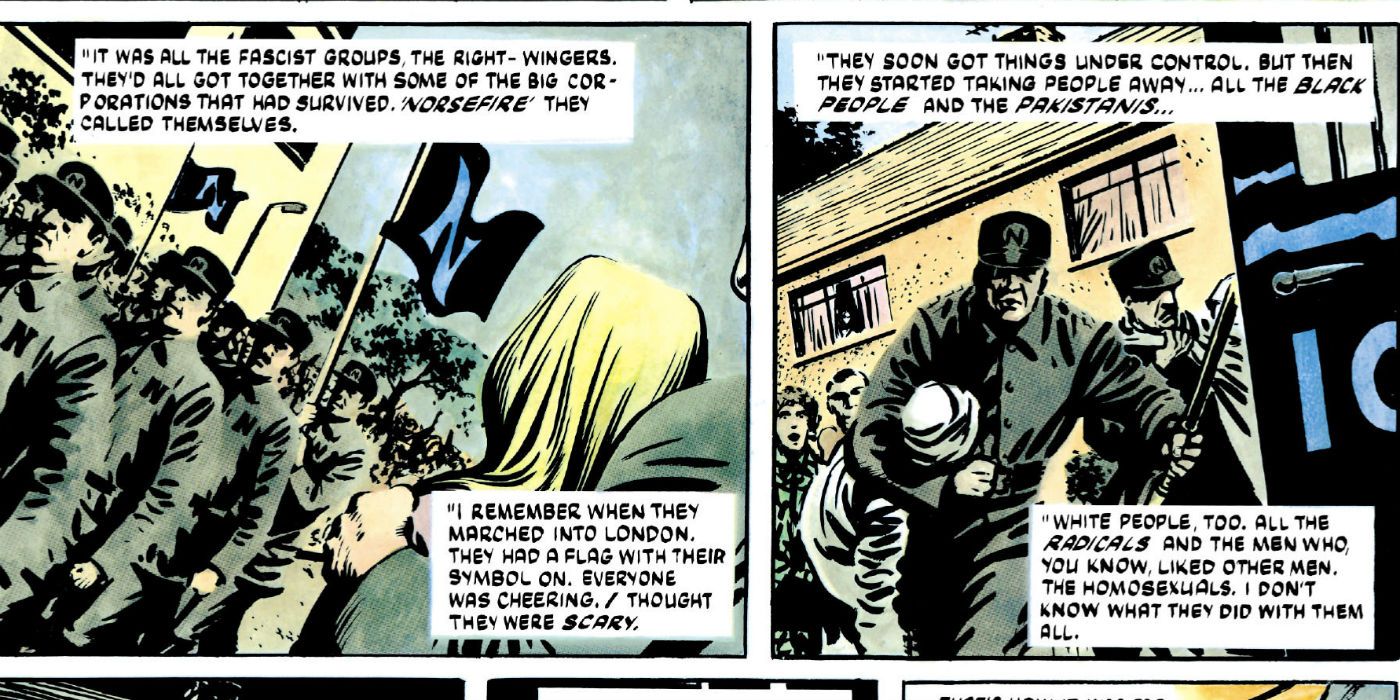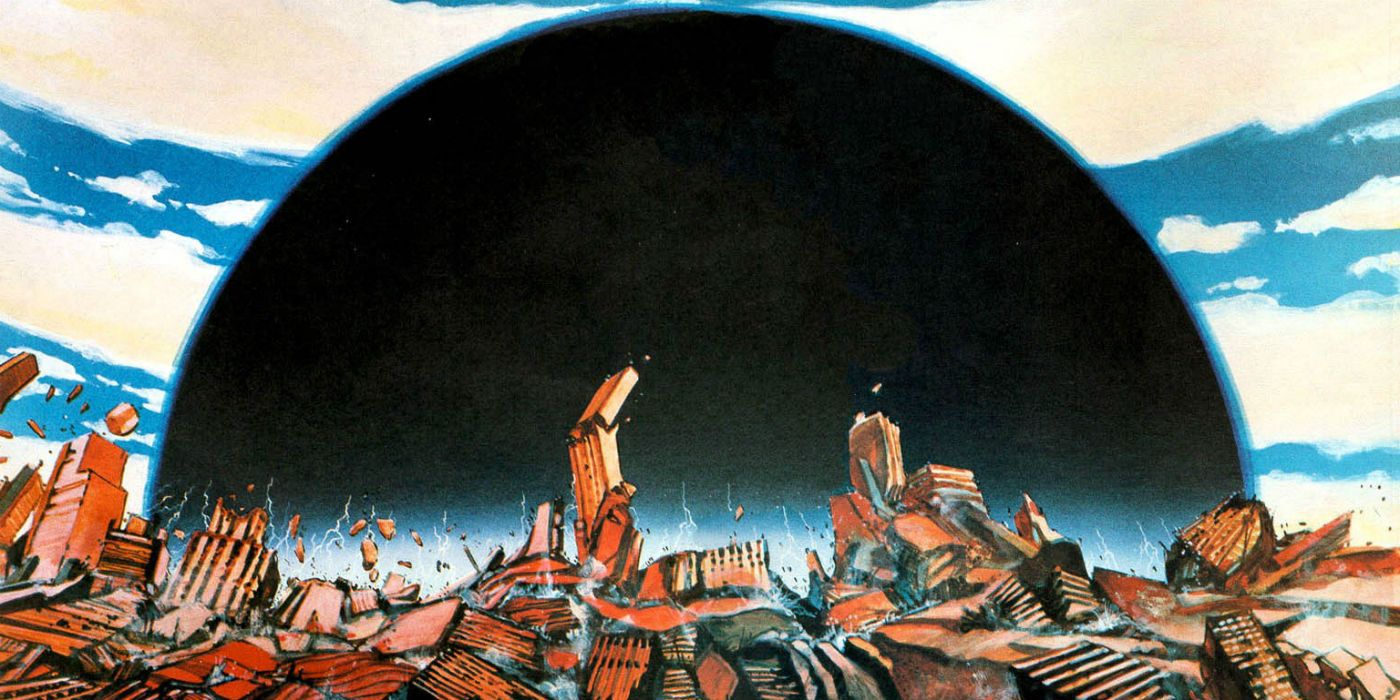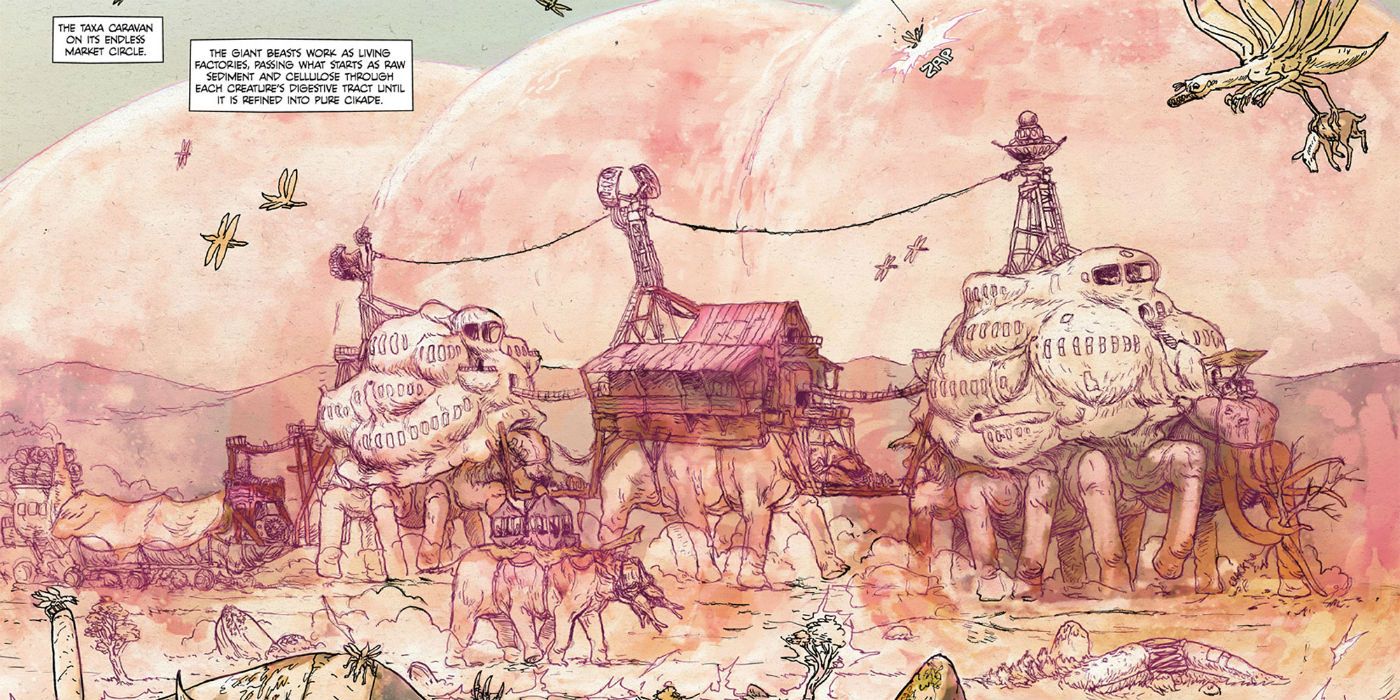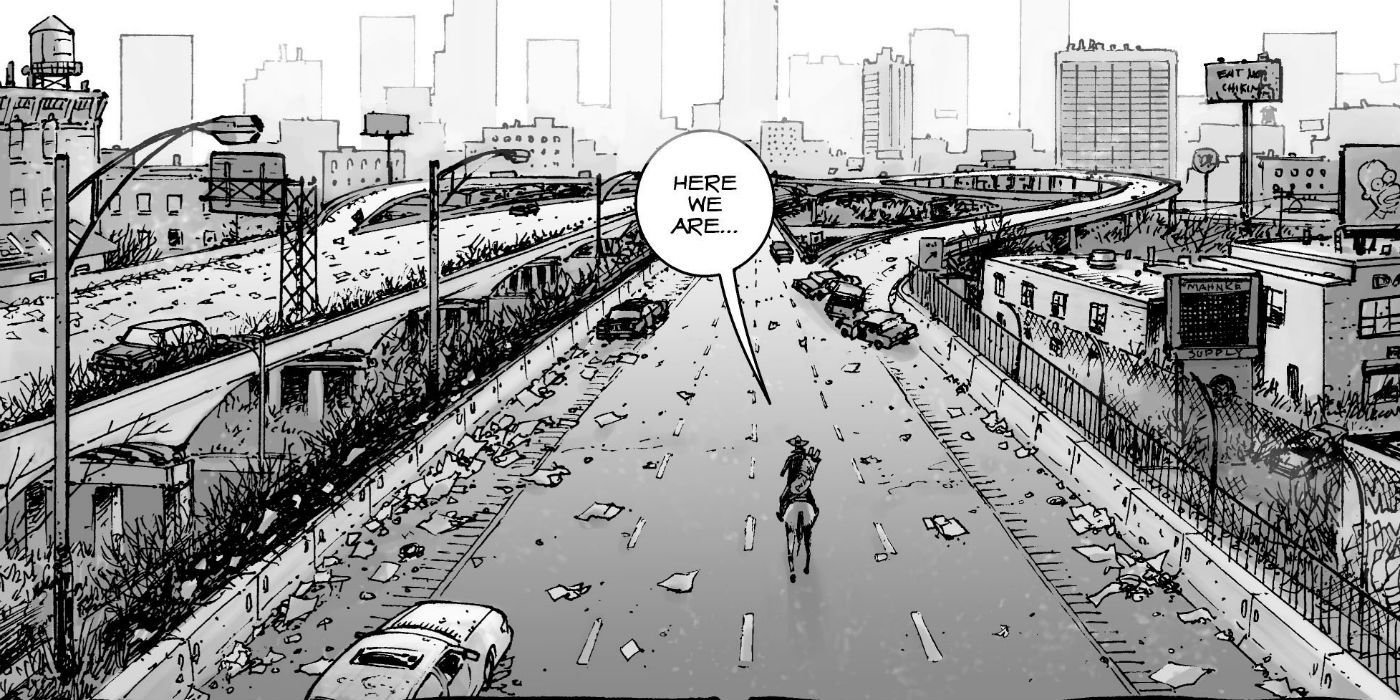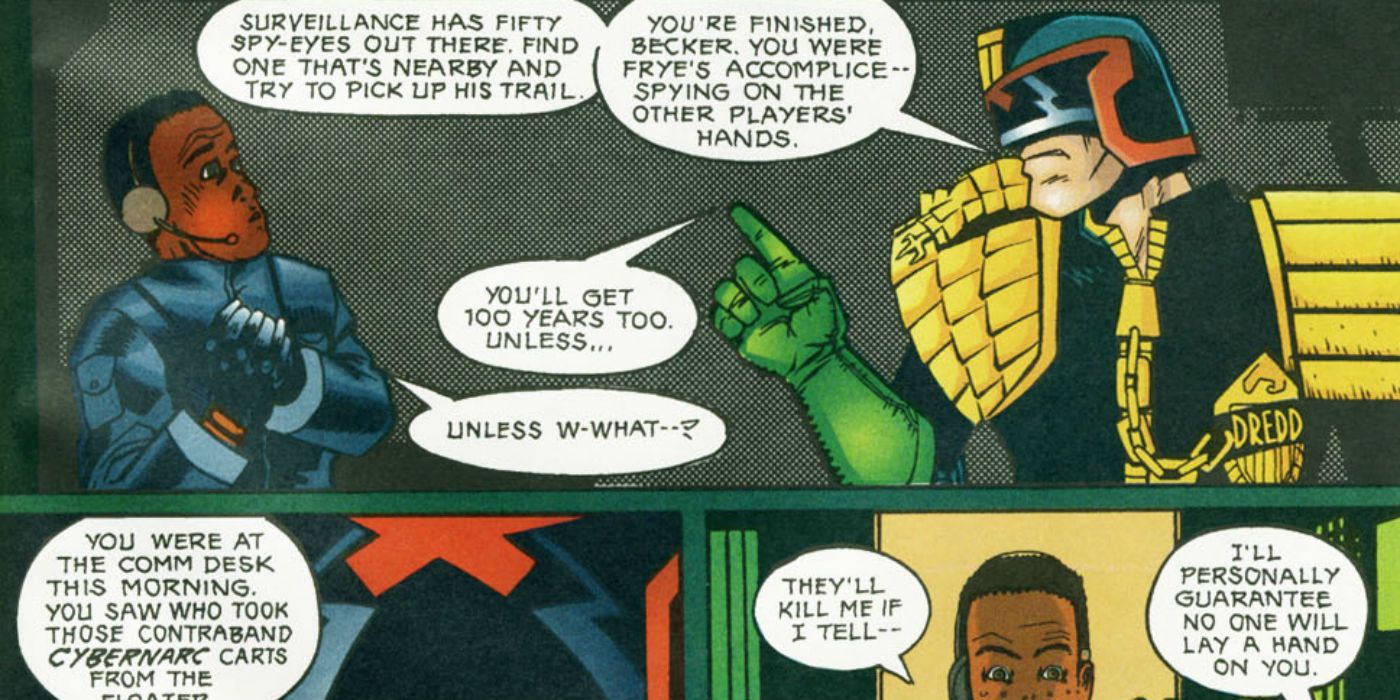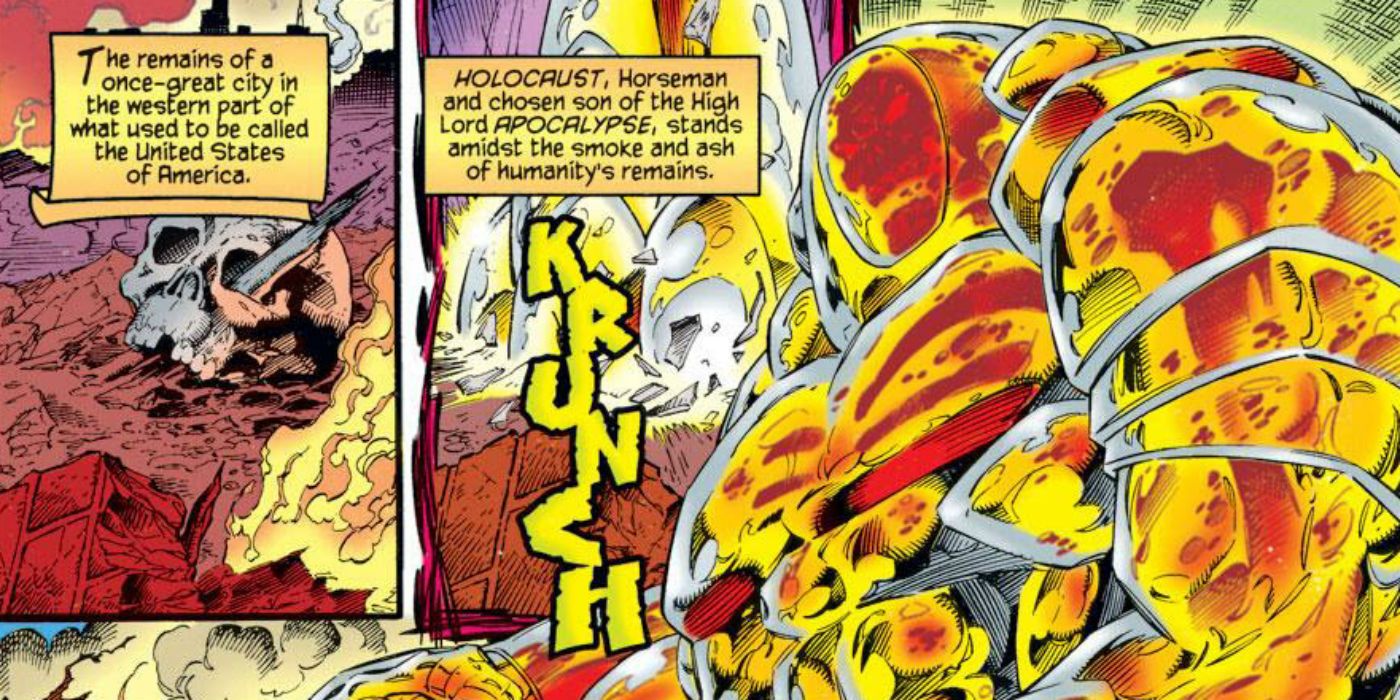Now, more than ever, there's been an increase in interest for dystopian stories. Whatever your stance on politics, there's no question that governments around the world have been leaning more right, choosing anti-establishment leaders who promise to reunite their countries and keep the "other" out. These messages of united, utopian futures can easily fall away to reveal ulterior motives, a means of controlling the masses and encouraging a divide between the loyalists and those who stand opposed. Even in the 1940s, post-World War II, George Orwell saw the dangers of surveillance, televised thought control, and group-think as a means of keeping people in line with his famous novel, 1984.
In comics, too, there have been a number of darkly disturbing dystopian stories, many of which emerged out of the tumultuous economic recession of the 1980s. These fictional worlds show the dangers associated with class warfare, government-run media, uncontrolled reliance on technology, and the dangers of consumerism replacing any sort of spirituality or sense of right and wrong. These stories, combined with their graphic visuals, serve as a reminder of what may be if the people give up their power in exchange for complacency. Films like the recently released Logan and the upcoming Ghost in the Shell have adapted these stories and once again brought their message to the forefront of pop culture, making our collection of the 15 Most Disturbing Dystopias In Comics all the more relevant.
15. Jihad/The Horde
Imagine if Russia was run by an L. Ron Hubbard type and aliens in UFOs have abducted the body of Vladimir Lenin. Then imagine said ruler wants a worldwide empire that stretches from ocean to ocean and decides he needs the supposed reincarnation of Genghis Khan in order to accomplish his goal. Wacky as these scenarios may be, they only scratch the surface of the complexities explored in Jihad.
It’s as if the author, Igor Baranko, took every Russian conspiracy theory and idea about eastern mysticism and jammed them into a drug-induced nightmare scenario. In this world, the Chechnyan people have all but been wiped out by a nuclear bomb, and Ukraine is the only free state in Europe. The dictator is clearly delusional, obsessing over the Russian people’s supposed descendance from the Mongols and Genghis Khan’s Golden Horde. Meanwhile, as his soldiers play Russian roulette, you can’t help but laugh at the whole concept’s morbid absurdity, one that’s both uncomfortable and fascinating — like watching a trainwreck.
14. Ghost in the Shell
Centering mainly on a highly advanced technological future involving the cyberization of the human mind via the internet, Ghost in the Shell takes place after multiple world wars changed the geopolitical landscape and left Japan in a position of power. Although a democracy, the government consistently surveils and polices its people due to consistent cyberterrorism and cyberbrain hacking. The main character, Major Motoko Kusanagi, is part of one of these terrorism-fighting units called Public Security Section 9.
Kusanagi is a full cyborg, who was saved from a childhood illness by cyberization, but has only retained part of her original brain. Because of the frequency of cyberization, a new disease has developed called cyberbrain sclerosis, which definitively hardens brain tissue and is incurable. One of the many examples of government corruption comes when it’s revealed there’s a vaccine for the disease that’s being withheld from the public but is accessible to the rich and famous. Although Ghost in the Shell's dystopian future is scary for its technological extremism, perhaps it will serve as a warning for knowing how far is too far before it’s too late.
13. Lazarus
A cross between The Hunger Games and Mad Max (although seen from the oppressor’s point of view), Lazarus is a relatively recent comic series created by Greg Rucka and Michael Lark. It follows the story of Forever, the chosen Lazarus (or warrior) for the Carlyle family. The world has been divided into sixteen territories, each ruled by a different family. Although the groups only consist of a handful of people, they hold all the power.
In this dystopian future, there is no government, and anyone who isn’t part of the ruling class is either categorized as “serfs,” meaning workers in this scenario, or “waste.” The majority of people, millions, in fact, are therefore considered waste and treated as such. On the other hand, the families have access to highly advanced medical technology which can prolong life and even bring someone back from the brink of death. In short, it’s a not so unrealistic adaptation of class divisions in society if they were to get unbelievably extreme, especially without a centralized government behind them.
12. Marshal Law
Undoubtedly ahead of its time, Marshal Law did superhero dystopia before it was even a thing. It was one of the first comics to flip the image of a superhero on its head, as most of them are considered bad, or at the very least hypocritical, in this world. The character, Marshal Law, was even a superhero himself, genetically engineered as a super-soldier of sorts. His mission? To clean up the streets and bring down mutated superheroes who went rogue.
Set amongst the ruins of an earthquake-devastated San Francisco, the government subsidized Marshal Law doles out his unique brand of justice amidst a city plagued by debauchery, murder, and crime. It’s a bleak future, but one not so far removed from the past, present, or the future. In fact, the United States government has already been working on military technology that will eventually make US soldiers indestructible, with impenetrable exoskeleton body armor (which will supposedly be ready next year), wireless brains that don’t require sleep, and even pain vaccines. The latter is similar to the pain-free superheroes in Martial Law, who inflict pain on others to compensate, making this dystopia hit a little too close to home.
11. American Flagg
Written in the 1980s, but set in our near future, American Flagg chronicles the fate of America in the wake of a series of global catastrophes (disease, famine, nuclear war, etc.) After the government and a bunch of major corporations leave Earth for Mars, remaining powers join together under a massive super-corporation called Plex. Essentially, it governs the US and controls the masses via giant Plexmalls, an Earth-run militia, and a single state-run TV network. The rules of law are varied and weird, including making prostitution legal but pro-sports illegal.
American Flagg ultimately follows Reuben Flagg, a former TV star who’s replaced by a CGI counterpart. Like a neo-Western, Flagg becomes a sheriff of sorts, cleaning up the mess left behind by the government. He joins the militia (called the Plexus Rangers), in what was once Chicago, working to expose violent subliminal messages on TV, investigate a murder, and uncover an underground TV station — to name a few of his many accomplishments. It’s political satire at its best, paired with tinges of eerie prophecy that’ll make you laugh nervously as you take in the mayhem.
10. Kamandi: The Last Boy on Earth
In Kamandi: The Last Boy on Earth, the majority of human life has been wiped out by a series of environmental catastrophes on par with some of the worst disaster movies you’ve ever seen. In their place, a race of Animal-Men — mutated by the combined effects of nuclear radiation and an experimental drug called Cortexin — rule the world and become the dominant species. Anthropomorphic rats have overrun New York, gorilla-people occupy the midwest, and tigers have started a new empire, naming a caesar and battling with neighboring factions for control.
If that wasn’t terrifying enough, humans are treated like the animals, with many devolving into a caveman-like sub-species. They’re either kept as pets, slaves, or made to fight in arena-style deathmatches with each other (an ironic twist, considering how many animals were slaughtered during these bloody contests). Kamandi is one of the few humans left with a fully-functioning brain. As he finds others like him, they join forces to rescue humanity and bring their kind back from the edge of extinction.
9. Old Man Logan
The future looks pretty bleak in this Marvel storyline, which the recently released Logan film borrows heavily from. It’s pretty safe to say that no one would want to live in a world where Red Skull is in the White House. Old Man Logan takes place in an alternate future where Logan/Wolverine has given up his mantle and started a family, driven to pacifism by the destruction of the X-Men at his own hands (or claws, if you want to get technical about it). As a result, the U.S. became overrun by supervillains, driving any remaining superheroes into hiding.
Everywhere you turn, there’s some kind of horrible fate that awaits you: Moloids (creatures who sink cities and destroy human life), freely roaming dinosaurs (including a T-Rex with a venom-symbiote), punk gangs of Ghost Riders. Not to mention the faded legacy of superheroes confined to what was formerly Las Vegas, which has been reduced to a hotbed of consumerism and literal hero-worship. It’s all a sad sight to behold despite a sprinkling of comic relief here and there.
Various aspects of the dystopian landscape were left unadapted for the cinematic Logan -- probably because the storyline was already incredibly dark without all the end of the world stuff.
8. The Incal
After a failed attempt at adapting Frank Herbert’s Dune novel into a film, Alejandro Jodorowsky combined many of those unused concepts into a comic series with illustrator Jean Giraud. The result is a fever dream of epic space-opera proportions that speaks of the human condition and the rejection of physical endeavors over spiritual ones.
Everyone’s after the main character, John Difool, for a light crystal he was given in a ventilation shaft. He’s forced to navigate the city amid cybo-cops, technopriests, wolf-men, mutants, and an alien race of featherless birds called The Berg. The Incal’s dystopia is one of excess and very obvious class separation, with poorer castes dominated by richer ones.
Like many of the other comics on this list, the masses are controlled by television programs, which often incite them to violence and even broadcast the clonage of the president into his new body. Sexual credit unions (futuristic brothels) are introduced, and the upper class’ purity is mocked by depicting them as wearing halos on their heads. It’s a hedonistic fantasy world where even in death, you’re harvested for parts.
7. Transmetropolitan
The City in Transmetropolitan is a perfect example of what happens when you let the public indulge in every twisted fantasy they might have — just to keep them happy and numb to everything else that’s going on. Genetic mutation is as natural as getting a piercing in this world; you can become half alien, half animal, or even a pink cloud of nano-machines.
TV is a part of the propaganda machine, telling people what they want to hear and broadcasting pretty much everything, no matter how violent or messed up it may be. It’s used as a tool by the police to incite a riot and even as a big middle finger to the main character, gonzo journalist Spider Jerusalem, when one of the presidential candidates has his political director murdered on camera.
Somehow, the politicians in Transmetropolitan are even more corrupt and fake than the ones you'll find in the real world, which has to give you some piece of mind (at least for now). There have been numerous comparisons to candidates over the past twenty years since the series debuted, though. Hopefully, that’s as far as the similarities will go, although we could really use a Spider Jerusalem-type right about now.
6. V For Vendetta
Like in American Flagg, the government and corporations banded together, this time in Great Britain, to emerge as a superpower in V for Vendetta. In a setting that’s very reminiscent of George Orwell’s 1984 novel, they formed an extreme right-wing fascist party, which controlled every aspect of society and again operated with a centralized television network. Internment camps were set up like in Nazi Germany, and those who showed any type of disloyalty to the state disappeared into the night, never to be seen again.
Aside from the Big Brother-like TV, nicknamed "The Mouth," creepy state policemen roam the streets, ready to rape or kill anyone who’s out past curfew. It’s V, a masked and caped revolutionary, who inspires the people to finally fight back. Through him, we see just how deep the rabbit hole goes, as he has an entire lair filled with things that are presently considered contraband. It’s a nightmarish look at when extreme control is allowed to go unopposed, and that those in power will do anything to stay there.
5. Akira
Nuclear war is a common theme in dystopian literature and comics, where countries desperately try to rebuild after near annihilation. So the story goes in Akira, when World War III destroys much of the world, including Tokyo. Even after it’s rebuilt, the new city is just as permeated with violence, corruption, and government control. Gangs rule the streets, and anti-government terrorism strikes fear into the heart of the city.
Amidst all the violence, the city holds a secret of great power, a cause and effect of the inherent disease that still plagues the city despite its supposed revitalization. Hoping to utilize psychic powers as a type of biological weapon, the government of Tokyo experimented on a small group of children, giving them drugs to control their psychic energy. As is usually the case when humans mess with nature -- or in this case, the very nature of the mind -- things spiral out of control, causing massive damage. Akira serves as a reminder that even in man's desire to evolve beyond violence, we often are the instruments of our own destruction.
4. Prophet
Much like Captain America, John Prophet was subjected to a number of experiments designed to give him superhuman abilities. Unlike the Star-Spangled Avengers, however, he was made to serve evil, not fight it. After his creator had a change of heart, however, he was cryogenically frozen and cloned into aggressive super-soldiers, who are sent many thousands of years into the future to serve the Earth Empire.
In the meantime, most of humankind has now been wiped off the face of the planet due to a galaxy-spanning war of epic proportions. Those left are scattered on alien worlds, only tied to freaky beings called brain-mothers who form a psychic link with them. In place of humans are a number of insectoid aliens, xenomorphs, and parasites who are part of a multi-faceted caste system based on smell and fermentation. Amongst the gross sites seen in a society overrun by giant insects is a caravan of aliens who feed off each other’s waste and then sell off the final byproduct. Although the artwork is magnificent, there’s nothing pretty about the world John Prophet is forced to navigate.
3. The Walking Dead
While The Walking Dead mainly functions as a post-apocalyptic scenario, there are elements of dystopia there, too. Nothing ever gets too much better before it gets worse again, and there are always constant threats from zombies and other people. Even when groups of people band together in a community — attempting to form some semblance of normalcy, law, and order — when they let down their guard, it only brings about destruction and death.
The Walking Dead has one of the few worlds where there’s always a return to anarchy and survivalism without government intervention. The survivors are left to fend for themselves, although various leaders certainly emerge. Each group functions as a gang, fighting for turf, food, and supplies, never truly trusting others the way they trust their own. Despite the lack of a corrupt government intervening in their lives, their reality is often a lot worse than the others on this list. The desperation of living only to survive another day (without real purpose) takes its toll and introduces a level of savagery that’s almost unfathomable except in times of war.
2. Judge Dredd
Taking place in the 22nd century, Judge Dredd sees the United States under a police state of an authoritarian regime. In addition to regular police officers, who are every bit as corrupt and felonious as the criminals they’re supposed to apprehend, there are also special “street judges.” Judge Dredd is the most feared of these law enforcement officials, who can sentence perps on the spot and even execute them for extreme crimes. There’s no innocent until proven guilty here, even for minor infractions. Any disagreement with a judge can also tack on extra time, like parents punishing their children for talking back.
Much of the world has been devastated by war, leaving the majority of land radioactive and unfit for habitation. Populations have compensated by concentrating in mega-cities like the one Judge Dredd operates out of. The specifics of the devastation on each continent is a lot more extensive than some of the other comics on this list. There are very specific conflicts and nuclear wars mentioned, creating a very fleshed out, but terrifying, universe that even the film adaptations couldn't quite touch.
1. X-Men: Age of Apocalypse
Despite the less than stellar movie adaption of this X-Men storyline, Age of Apocalypse contains some of the most disturbing dystopian concepts in comics. What if an ancient, immortal, all-powerful mutant began conquering the world, starting with North America? Believing mutants to be superior, this being, Apocalypse, organizes a genocide against the human race, killing millions. The horror doesn’t stop there, however; deceased humans and mutants are harvested for their genes, which in turn are used to create his soldiers. Those that remain are resettled amongst a dystopian landscape destroyed by his Four Horsemen, who take their names from their biblical counterparts: Death, War, Famine, and Pestilence.
Prisoner and slave camps are set up to hold both humans and mutants who resist Apocalypse’s reign. What’s more, since this is an alternate timeline, many heroes aren’t around to fight back (Professor X) or are killed before they can even become their alter-ego (Peter Parker). It’s a bleak future, but luckily one that was eventually reversed by Bishop (although it was later revisited as an alternate Earth timeline in the mid-2000s).
--
What other incredibly disturbing comic dystopias would you rather not see become a reality? Let us know in the comments.

